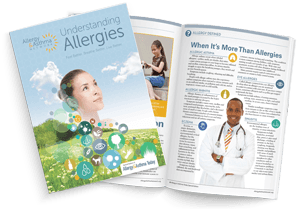Allergy Diagnosis & Testing
- Home
- |
- A Complete Guide to Allergies
- |
- Allergy Diagnosis and Testing
How are seasonal and environmental allergies diagnosed?
It is important to know which allergens cause you to have symptoms. Once you learn what you are allergic to, you will be able to work with your allergist to develop a plan to reduce your symptoms.
- The first thing to do is see a board-certified allergist, who will do the following:
- review your health history and your family’s health history
- ask about the frequency and severity of your symptoms
- ask what activities might expose you to allergens
- ask about your home and work environments
- perform a physical exam of your eyes, ears, nose and lungs
Your allergist may recommend allergy testing. Allergy testing will be used to pinpoint which allergens are affecting you. A positive test reveals you are sensitized to a particular allergen. The allergist will then put all the evidence together to reach a diagnosis.
Consider taking the Rhinitis Control Assessment Test before you visit your doctor. The test will look for clues to whether you have allergic rhinitis, or nasal allergies.


Download Our Free “Understanding Allergies” Guide
What are the types of testing used for seasonal or environmental allergies?
Here are various ways in which a board-certified allergist specialist can determine if you have allergies and what kind.
Skin prick tests
Droplets of suspected allergens are placed on or just under the skin surface. Raised bumps (about the size of a mosquito bite) strongly indicate an allergy to that substance. Results are typically known within 20 minutes. Skin prick tests are used most often because of accuracy, ease of use and immediate results.
Blood tests
Blood tests are chemical tests that detect Immunoglobulin E (IgE) antibodies. These antibodies circulate in your blood for specific allergens. Lab results may take days. Blood tests are often used for patients with skin sensitivities or medication requirements that prevent skin testing. Tests may measure specific or overall levels of IgE. Some tests also break down common allergens and measure IgE to specific components.
How accurate is allergy testing?
Skin and blood tests are very accurate in showing a sensitivity to a particular environmental allergen. A positive result, though, doesn’t mean that you will develop symptoms when exposed to the allergen.
That’s why it’s important to work with a board-certified allergist. An allergist will know how to put your test results together with your personal history to make an accurate diagnosis.
What should I expect if I undergo allergy testing?
Careful, thorough, knowledgeable and evidence-based care that includes:
- A complete history of your allergy symptoms and allergies in your family
- Appropriate allergy tests: skin or blood tests
- Properly interpreted test results by a board-certified allergist
- Any other tests, such as a physical exam, that are necessary
- A detailed treatment plan that consists of allergen avoidance, possible medication, and/or immunotherapy
Ask the Allergist: how often should I be retested for allergies?
What are my expenses for allergy testing?
Before scheduling an allergy testing appointment with an allergist, check your medical policy to ensure you understand your insurance benefits. Current federal legislation requires most insurance companies to cover costs of screening for allergy and asthma.
Also, check your billing statement to ensure it is billed appropriately.
Do I have allergies? Or do I have a cold, flu or sinusitis?
Sometimes it is hard to tell if you have allergies, or if your symptoms could be due to a cold, or flu or sinus infection. The following chart can help you tell the difference.


Quick 3-5 minute videos on asthma, allergies, and related conditions.
Visit Our Other Pages for More Allergy Information, Webinars, Posters, Infographics, and more!
Assistance Programs for Medications
Allergy Online Store
Allergy Posters
Allergy Webinars
Allergy News
Allergy Facts
Allergy Dictionary
Allergy Medication & Treatment
Are there other conditions that can look like or complicate allergies
There are other types of conditions that can mimic allergies, but are different than an IgE-mediated allergy. The symptoms, diagnosis and treatment can vary depending upon the condition. Here are some of them.
Food-related conditions that can have symptoms similar to food allergies include:
